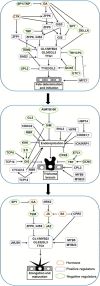Molecular Mechanisms of Plant Trichome Development
- PMID: 35720574
- PMCID: PMC9198495
- DOI: 10.3389/fpls.2022.910228
Molecular Mechanisms of Plant Trichome Development
Abstract
Plant trichomes, protrusions formed from specialized aboveground epidermal cells, provide protection against various biotic and abiotic stresses. Trichomes can be unicellular, bicellular or multicellular, with multiple branches or no branches at all. Unicellular trichomes are generally not secretory, whereas multicellular trichomes include both secretory and non-secretory hairs. The secretory trichomes release secondary metabolites such as artemisinin, which is valuable as an antimalarial agent. Cotton trichomes, also known as cotton fibers, are an important natural product for the textile industry. In recent years, much progress has been made in unraveling the molecular mechanisms of trichome formation in Arabidopsis thaliana, Gossypium hirsutum, Oryza sativa, Cucumis sativus, Solanum lycopersicum, Nicotiana tabacum, and Artemisia annua. Here, we review current knowledge of the molecular mechanisms underlying fate determination and initiation, elongation, and maturation of unicellular, bicellular and multicellular trichomes in several representative plants. We emphasize the regulatory roles of plant hormones, transcription factors, the cell cycle and epigenetic modifications in different stages of trichome development. Finally, we identify the obstacles and key points for future research on plant trichome development, and speculated the development relationship between the salt glands of halophytes and the trichomes of non-halophytes, which provides a reference for future studying the development of plant epidermal cells.
Keywords: development; epidermal cell; molecular mechanism; plant; trichome.
Copyright © 2022 Han, Li, Yang, Wang, Zhang and Wang.
Conflict of interest statement
The authors declare that the research was conducted in the absence of any commercial or financial relationships that could be construed as a potential conflict of interest.
Figures





Similar articles
-
[Research progress in regulation model in different types of plant trichome].Sheng Wu Gong Cheng Xue Bao. 2020 Oct 25;36(10):2051-2065. doi: 10.13345/j.cjb.200114. Sheng Wu Gong Cheng Xue Bao. 2020. PMID: 33169570 Review. Chinese.
-
Trichome-Related Mutants Provide a New Perspective on Multicellular Trichome Initiation and Development in Cucumber (Cucumis sativus L).Front Plant Sci. 2016 Aug 10;7:1187. doi: 10.3389/fpls.2016.01187. eCollection 2016. Front Plant Sci. 2016. PMID: 27559338 Free PMC article. Review.
-
Transcriptome profiling of trichome-less reveals genes associated with multicellular trichome development in Cucumis sativus.Mol Genet Genomics. 2015 Oct;290(5):2007-18. doi: 10.1007/s00438-015-1057-z. Epub 2015 May 8. Mol Genet Genomics. 2015. PMID: 25952908
-
Comparative morphoanatomy and transcriptomic analyses reveal key factors controlling floral trichome development in Aristolochia (Aristolochiaceae).J Exp Bot. 2023 Nov 21;74(21):6588-6607. doi: 10.1093/jxb/erad345. J Exp Bot. 2023. PMID: 37656729
-
Promoter of a cotton fibre MYB gene functional in trichomes of Arabidopsis and glandular trichomes of tobacco.J Exp Bot. 2008;59(13):3533-42. doi: 10.1093/jxb/ern204. Epub 2008 Aug 18. J Exp Bot. 2008. PMID: 18711121 Free PMC article.
Cited by
-
BEACH domain-containing protein SPIRRIG facilitates microtubule cytoskeleton-associated trichome morphogenesis in Arabidopsis.Planta. 2024 Oct 14;260(5):115. doi: 10.1007/s00425-024-04545-5. Planta. 2024. PMID: 39400709
-
The trichome pattern diversity of Cardamine shares genetic mechanisms with Arabidopsis but differs in environmental drivers.Plant Physiol. 2024 Dec 2;196(4):2730-2748. doi: 10.1093/plphys/kiae213. Plant Physiol. 2024. PMID: 38606947 Free PMC article.
-
The bHLH transcription factor gene EGL3 accounts for the natural diversity in Arabidopsis fruit trichome pattern and morphology.Plant Physiol. 2024 Dec 23;197(1):kiae673. doi: 10.1093/plphys/kiae673. Plant Physiol. 2024. PMID: 39709618 Free PMC article.
-
Unraveling the Complexity of Plant Trichomes: Models, Mechanisms, and Bioengineering Strategies.Int J Mol Sci. 2025 Jul 21;26(14):7008. doi: 10.3390/ijms26147008. Int J Mol Sci. 2025. PMID: 40725255 Free PMC article. Review.
-
C2H2 Zinc Finger Proteins GIS2 and ZFP8 Regulate Trichome Development via Hormone Signaling in Arabidopsis.Int J Mol Sci. 2025 Jul 27;26(15):7265. doi: 10.3390/ijms26157265. Int J Mol Sci. 2025. PMID: 40806397 Free PMC article.
References
Publication types
LinkOut - more resources
Full Text Sources

